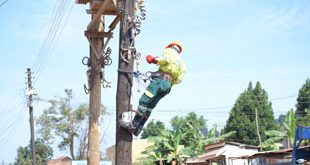
By Andrew M. Mwenda
An insightful visitor to Uganda today would confront a puzzle: there is a lot of activity in our country. The government has many programmes to develop the country and improve the living conditions of its people. There is Prosperity For All and the president moves around the country dishing out cash to selected individuals and groups.

We have programmes like Universal Primary and Secondary Education (UPE and USE). The boom in education is real and both the state and the private sector are rapidly expanding its reach. The number of students getting government scholarships to study at university has doubled while the number of privately sponsored students at universities has grown from zero in 1990 to over 20,000 in 20 years.
In health, government, donors, NGOs and the private sector are investing a lot. As President Yoweri Museveni never tires of reminding us, his government has built 750 Grade III hospitals in every sub-county. More money is poured to buy drugs. The total money going to the health sector this ending financial year is Shs 1.3 trillion ‘ almost 90% of the total budget of the entire government of Rwanda.
Then when our roads became a sea of potholes, the government immediately increased the infrastructure budget to one trillion. When an acute energy crisis stared the nation in the eye, the government created an energy fund in which over Shs 120 billion is allocated every year. Big plans to increase generation of electricity by 500MW have been announced.
The economy itself has been growing at an impressive 9% per annum, and in spite of the international economic meltdown, our GDP has grown by 6.7% this financial year. Although tax revenues are Shs 150 billion below projections, they are 17% above revenues collected last financial year. The private sector is booming ‘ more cars on the streets, more banks have been licensed and more telecommunication companies are entering the market. Exports are growing and shopping malls springing up etc.
In the governance sphere, there is a lot of media freedom and newspapers, radios and televisions provide lively public debate. There are NGOs and public bodies on every arm and leg of our existence promoting ‘accountability’ and prosecutions of the corrupt are at an all time high. Parliamentary committees and commissions of inquiry add to an atmosphere of vibrancy. Elections are competitive with a strong anti-incumbency bias where nearly half of all MPs are never returned.
Yet this is one side of Uganda’s coin. The other side is tragic. For all the billions going to public health and education, there are no drugs in hospitals or books in schools; doctors, nurses and teachers’ absenteeism is atrocious. People no longer turn up at public dispensaries for treatment and the dropout rate from free primary education is 78%. Museveni’s new 750 dispensaries and 30,000 classrooms are mere monuments.
In spite of the multitudes of institutions of accountability, public officials loot public resources with impunity. Although there are many prosecutions of the corrupt, the cases involve small district officials. The big fish in Kampala walk free. The president himself leads this pack of the corrupt and presides over profligate expenditure on State House. The institutions at the centre have limited capacity to direct things at district level, thus decentralising and democratising corruption.
Within our lively public debate, critical individuals have no access to the air waves and newspapers. The state has bribed, intimidated and co-opted most media institutions and individual journalists ‘ only a handful remaining in the few truly independent media. At parliament, the accountability committees controlled by the opposition are more corrupt than the committees controlled by the ruling party. Even in the churches priests lie, rape and steal from their parishioners.
Public institutions and policies no longer embody a collective vision. Instead, they have been turned into a vehicle through which those in control of the state loot public resources with reckless abandon. Of all the billions that government has allocated to health, education and infrastructure, only a small fraction goes to the intended purpose, the rest ending up in private pockets. A lot of private wealth in today’s Uganda has been accumulated at the price of the atrocious record in public service delivery.
How does one reconcile Uganda’s phenomenal economic growth, boom in education, strong democratic traditions, a growing middleclass and elite institutions with the depth of public corruption, impunity of officialdom, institutionalised incompetence and unparalleled apathy and cynicism in the public?
How do we label this state? Is it strong or weak; developmental or predatory? Its propensity to design high sounding policies is very high. Yet its capacity to implement them is disastrous. It has proven capable of sustaining economic growth yet incapable of delivery of basic things like law enforcement, health and education services provision. Even tax collection where it has a vested interest, the state in Uganda has proven too weak to deliver. So in every routine service, there is rampant corruption, absenteeism, institutionalised incompetence and indifference.
Government critics feel that all this is because of a democratic deficit in our country. Yet it seems to me that most of the aforementioned dysfunctions are a product of a democratic bargain. In its desire to stay in power, the NRM finds itself under strong electoral pressures. To win over different ethnic groups in our multi-tribal society, it adopted as its strategy the buying of elite support through patronage. As more resources are diverted to integrate large sections of the elite into the eating circle, very few resources remain to deliver public goods and services.
The debate on improving governance in Uganda has focused on a copy and paste approach from western countries. It seems to me that behind most of Uganda’s institutional innovations lies an assumption that public officials have a strong commitment to the public interest. Yet the evidence staring us in our eyes demands that we think outside the box.
How can we make public officials develop a vested interest in improving the welfare of citizens? What threats can be sufficient to deter public loot? Is it possible to reform the public sector and make it more responsive to needs of our people?
amwenda@independent.co.ug
 The Independent Uganda: You get the Truth we Pay the Price
The Independent Uganda: You get the Truth we Pay the Price



